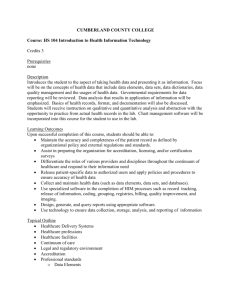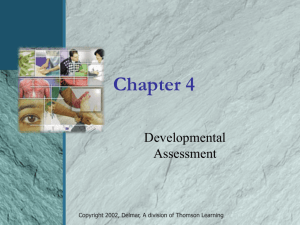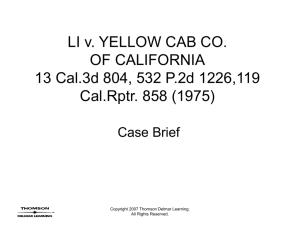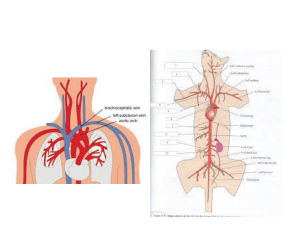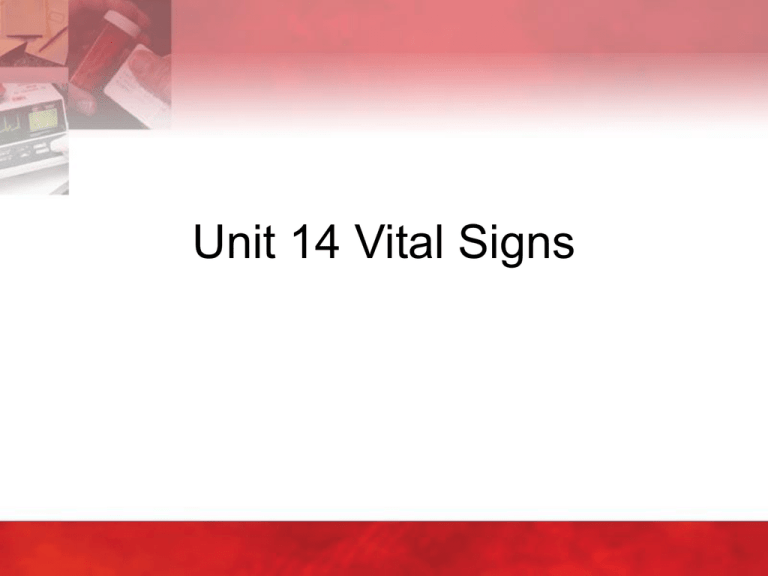
Unit 14 Vital Signs
14:1 Measuring and
Recording Vital Signs (VS)
Record information about the basic body
conditions
Main vital signs (VS)
– Temperature
– Pulse
– Respiration
– Blood pressure
Copyright © 2004 by Thomson Delmar Learning. ALL RIGHTS RESERVED.
2
Other Assessments
Pain – patients asked to rate on scale of 1
to 10 (1 is minimal and 10 is severe)
Color of skin
Size of pupils and reaction to light
Level of consciousness
Response to stimuli
Copyright © 2004 by Thomson Delmar Learning. ALL RIGHTS RESERVED.
3
VS Readings
Accuracy is essential
Report abnormality or change immediately
If unable to get reading, ask another
person to check
Copyright © 2004 by Thomson Delmar Learning. ALL RIGHTS RESERVED.
4
14:2 Measuring and
Recording Temperature
Measures balance between heat lost and
heat produced in the body
Heat produced by metabolism of food and
by muscle and gland activity
Homeostasis: constant state of
fluid balance
Conversion between Fahrenheit
and Celsius
Copyright © 2004 by Thomson Delmar Learning. ALL RIGHTS RESERVED.
5
Variations in Body
Temperature
Normal range
Causes of variations
Temperature measurements – oral, rectal,
axillary or groin, and aural
Abnormal conditions affecting temperature
Copyright © 2004 by Thomson Delmar Learning. ALL RIGHTS RESERVED.
6
Thermometers
Clinical thermometers
– Glass
– Electronic
– Tympanic
– Plastic or paper
Reading thermometers and
recording results
Copyright © 2004 by Thomson Delmar Learning. ALL RIGHTS RESERVED.
7
Thermometers
(continued)
Avoid factors that could alter or
change temperature
Cleaning thermometers
Paper/plastic sheath on
glass thermometer
Copyright © 2004 by Thomson Delmar Learning. ALL RIGHTS RESERVED.
8
14:3 Measuring and
Recording Pulse
Pressure of the blood pushing against
the wall of an artery as the heart beats
and rests
Major arterial or pulse sites
Pulse rate
Pulse rhythm
Copyright © 2004 by Thomson Delmar Learning. ALL RIGHTS RESERVED.
9
Measuring and
Recording Pulse (continued)
Pulse volume
Factors that change pulse rate
Basic principles for taking radial pulse
Recording information
Copyright © 2004 by Thomson Delmar Learning. ALL RIGHTS RESERVED.
10
14:4 Measuring and
Recording Respirations
Measures the breathing of a patient
Process of taking in oxygen and expelling
carbon dioxide from the lungs and
respiratory tract
One respiration: one inspiration (breathing
in) and one expiration (breathing out)
Normal respiratory rate
Copyright © 2004 by Thomson Delmar Learning. ALL RIGHTS RESERVED.
11
Measuring and Recording
Respirations (continued)
Character of respirations
Rhythm of respirations
Abnormal respirations
Voluntary control of respirations
Record information
Copyright © 2004 by Thomson Delmar Learning. ALL RIGHTS RESERVED.
12
14:5 Graphing TPR
Graphic sheets are special records used
for recording TPR
Presents a visual diagram
Uses
Color codes
Factors affecting VS are often noted on
the graph
Copyright © 2004 by Thomson Delmar Learning. ALL RIGHTS RESERVED.
13
Graphing TPR
(continued)
Graphic charts are legal records
To correct an error
Basic principles for completing
Copyright © 2004 by Thomson Delmar Learning. ALL RIGHTS RESERVED.
14
14:6 Measuring and
Recording Apical Pulse
Pulse count taken at the apex of the heart
Reasons for taking an apical pulse
Protect the patient’s privacy and
avoid exposure
Heart sounds
Abnormal sounds or beats
Copyright © 2004 by Thomson Delmar Learning. ALL RIGHTS RESERVED.
15
Measuring and Recording
Apical Pulse (continued)
Pulse deficit
Use the stethoscope
Placement of stethoscope
Measuring apical pulse
Record all information
Copyright © 2004 by Thomson Delmar Learning. ALL RIGHTS RESERVED.
16
14:7 Measuring and
Recording Blood Pressure
Measurement of the pressure the blood
exerts on the walls of the arteries during
the various stages of heart activity
Measured in millimeters of mercury on an
instrument called a sphygmomanometer
Measurements read at two points
Copyright © 2004 by Thomson Delmar Learning. ALL RIGHTS RESERVED.
17
Measuring and Recording
Blood Pressure (continued)
Systolic pressure
Diastolic pressure
Pulse pressure
Hypertension – high blood pressure
Hypotension – low blood pressure
Factors influencing
blood pressure readings
Copyright © 2004 by Thomson Delmar Learning. ALL RIGHTS RESERVED.
18
Measuring and Recording
Blood Pressure (continued)
Individual factors can all influence blood
pressure readings
Blood pressure is recorded as fractions
Types of sphygmomanometers
– Mercury
– Aneroid
– Electronic
Copyright © 2004 by Thomson Delmar Learning. ALL RIGHTS RESERVED.
19
Measuring and Recording
Blood Pressure (continued)
Factors to follow for accurate readings
Record all required information
Do not reveal the reading to the patient
Copyright © 2004 by Thomson Delmar Learning. ALL RIGHTS RESERVED.
20


